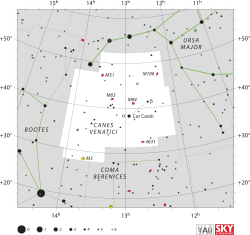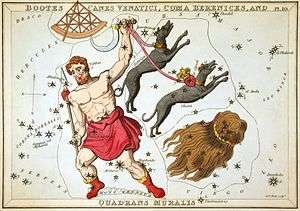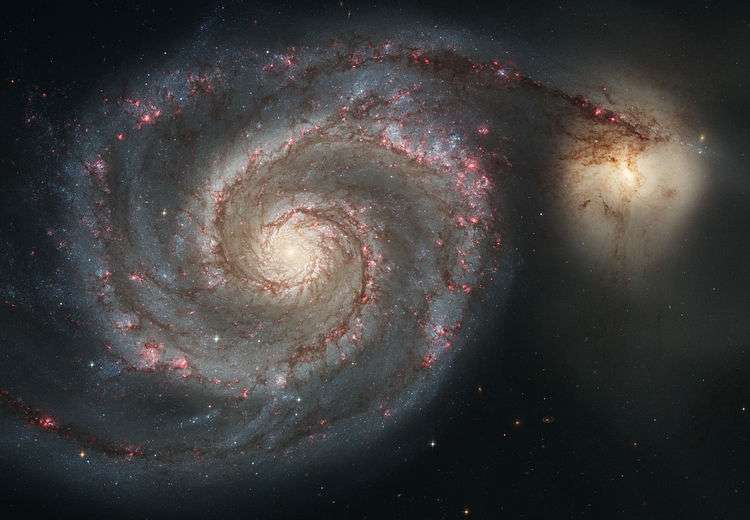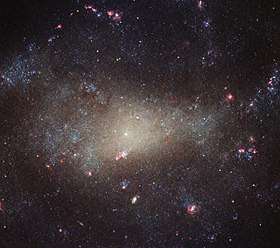Canes Venatici
Canes Venatici /ˈkeɪniːz vɪˈnætɪsaɪ/ is one of the 88 official modern constellations. It is a small northern constellation that was created by Johannes Hevelius in the 17th century. Its name is Latin for "hunting dogs", and the constellation is often depicted in illustrations as representing the dogs of Boötes the Herdsman, a neighboring constellation. Cor Caroli is the constellation's brightest star, with an apparent magnitude of 2.9. La Superba is one of the reddest naked-eye stars and one of the brightest carbon stars. The Whirlpool Galaxy is a spiral galaxy tilted face-on to observers on Earth, and was the first galaxy whose spiral nature was discerned.
| Constellation | |
 | |
| Abbreviation | CVn |
|---|---|
| Genitive | Canum Venaticorum |
| Pronunciation | /ˈkeɪniːz vɪˈnætɪsaɪ/ Cánes Venátici, genitive /ˈkeɪnəm vɪnætɪˈkɒrəm/ |
| Symbolism | the Hunting Dogs |
| Right ascension | 12h 06.2m to 14h 07.3m |
| Declination | +27.84° to +52.36°[1] |
| Quadrant | NQ3 |
| Area | 465 sq. deg. (38th) |
| Main stars | 2 |
| Bayer/Flamsteed stars | 21 |
| Stars with planets | 4 |
| Stars brighter than 3.00m | 1 |
| Stars within 10.00 pc (32.62 ly) | 2 |
| Brightest star | Cor Caroli (Asterion) (α CVn) (2.90m) |
| Messier objects | 5 |
| Meteor showers | Canes Venaticids |
| Bordering constellations | Ursa Major Boötes Coma Berenices |
| Visible at latitudes between +90° and −40°. Best visible at 21:00 (9 p.m.) during the month of May. | |
History


The stars of Canes Venatici are not bright. In classical times, they were listed by Ptolemy as unfigured stars below the constellation Ursa Major in his star catalogue.
In medieval times, the identification of these stars with the dogs of Boötes arose through a mistranslation. Some of Boötes's stars were traditionally described as representing the club (Greek κολλοροβος, kollorobos) of Boötes. When the Greek astronomer Ptolemy's Almagest was translated from Greek to Arabic, the translator Hunayn ibn Ishaq did not know the Greek word and rendered it as a similar-sounding compound Arabic word for a weapon, writing al-`aşā dhāt al-kullābالعصا ذات الكُلاب, which means "the staff having a hook". When the Arabic text was later translated into Latin, the translator, Gerard of Cremona, mistook kullāb كُلاب, meaning "hook", for kilāb كِلاب meaning "dogs". Both look the same in Arabic text when they don't have diacritics. Gerard writing it as: hastile habens canes ("spearshaft having dogs").[2][3][4][5] In 1533, the German astronomer Peter Apian depicted Boötes as having two dogs with him.[6][7]
These spurious dogs floated about the astronomical literature until Hevelius decided to specify their presence in the sky by making them a separate constellation in 1687.[8][9] Hevelius chose the name Asterion (from the Greek 'αστέριον, meaning the "little star",[10] the diminutive of 'αστηρ the "star", or adjective meaning "starry"[11]) for the northern dog and Chara (from the Greek χαρά, meaning "joy") for the southern dog, as Canes Venatici, the Hunting Dogs, in his star atlas.[9][12] In his star catalogue, the Czech astronomer Bečvář assigned the names Asterion to β CVn and Chara to α CVn.[13]
Characteristics
Canes Venatici is bordered by Ursa Major to the north and west, Coma Berenices to the south, and Boötes to the east. The three-letter abbreviation for the constellation, as adopted by the International Astronomical Union in 1922, is "CVn".[14] The official constellation boundaries, as set by Eugène Delporte in 1930, are defined by a polygon of 14 sides. In the equatorial coordinate system, the right ascension coordinates of these borders lie between 12h 06.2m and 14h 07.3m, while the declination coordinates are between +27.84° and +52.36°.[1] Covering 465 square degrees, it ranks 38th of the 88 constellations in size.
Features

Stars
Canes Venatici contains no bright stars, Alpha and Beta Canum Venaticorum being only of 3rd and 4th magnitude respectively. Flamsteed catalogued 25 stars in the constellation, labelling them 1 to 25 Canum Venaticorum, however 1 turned out to be in Ursa Major, 13 was in Coma Berenices, and 22 did not exist.[15]
- Alpha Canum Venaticorum, also known as Cor Caroli ("heart of Charles"), is the constellation's brightest star, named by Sir Charles Scarborough in memory of King Charles I, the deposed king of Britain.[9][16] Legend has it that α CVn was brighter than usual during the Restoration, as Charles II returned to England to take the throne. Cor Caroli is a wide double star, with a primary of magnitude 2.9 and a secondary of magnitude 5.6; the primary is 110 light-years from Earth. The primary also has an unusually strong variable magnetic field.[9]
- Beta Canum Venaticorum, or Chara, is a yellow-hued main sequence star of magnitude 4.2, 27 light-years from Earth. Its common name comes from the word for "joy".[9]
- Y Canum Venaticorum (La Superba) is a semiregular variable star that varies between magnitudes 5.0 and 6.5 over a period of around 158 days. It is a carbon star and is deep red in color.[9]
- AM Canum Venaticorum, a very blue star of magnitude 14, is the prototype of a special class of cataclysmic variable stars, in which the companion star is a white dwarf, rather than a main sequence star.
- RS Canum Venaticorum is the prototype of a special class of binary stars[17] of chromospherically active and optically variable components.
- R Canum Venaticorum is a Mira variable that ranges between magnitudes 6.5 and 12.9 over a period of approximately 329 days.
Supervoid
The Giant Void, an extremely large void (part of the universe containing very few galaxies) is within the vicinity of this constellation. It may be possibly the largest void ever discovered, slightly larger than the Eridanus Supervoid and 1,200 times the volume of expected typical voids. It was discovered in 1988 in a deep-sky survey.
Deep-sky objects
Canes Venatici contains five Messier objects, including four galaxies. One of the more significant galaxies in Canes Venatici is the Whirlpool Galaxy (M51, NGC 5194) and NGC 5195, a small barred spiral galaxy that is seen face on. This was the first galaxy recognised as having a spiral structure, this structure being first observed by Lord Rosse in 1845.[9] It is a face-on spiral galaxy 37 million light-years from Earth. Widely considered to be one of the most beautiful galaxies visible, M51 has many star-forming regions and nebulae in its arms, coloring them pink and blue in contrast to the older yellow core. M51 has a smaller companion, NGC 5195, that has very few star-forming regions and thus appears yellow. It is passing behind M51 and may be the cause of the larger galaxy's prodigious star formation.[18]
 Messier 51, the Whirlpool Galaxy, photographed by the Hubble Space Telescope.
Messier 51, the Whirlpool Galaxy, photographed by the Hubble Space Telescope. NGC 4248 is located about 24 million light-years away.[19]
NGC 4248 is located about 24 million light-years away.[19] NGC 4242 is a dim galaxy in Canes Venatici.[20]
NGC 4242 is a dim galaxy in Canes Venatici.[20] NGC 4631 photographed by the Hubble Space Telescope.
NGC 4631 photographed by the Hubble Space Telescope.
Other notable spiral galaxies in Canes Venatici are the Sunflower Galaxy (M63, NGC 5055), M94 (NGC 4736), and M106 (NGC 4258). M63, the Sunflower Galaxy, was named for its appearance in large amateur telescopes. It is a spiral galaxy with an integrated magnitude of 9.0. M94 is a small face-on spiral galaxy with an approximate magnitude of 8.0, about 15 million light-years from Earth.[9] NGC 4631 is a barred spiral galaxy, which is one of the largest and brightest edge-on galaxies in the sky.[22]
M3 (NGC 5272) is a globular cluster 32,000 light-years from Earth. It is 18' in diameter, and at magnitude 6.3 is bright enough to be seen with binoculars. It can even be seen with the naked eye under particularly dark skies.[9]
M94, also classified as NGC 4736, is a face-on spiral galaxy 15 million light-years from Earth. It has very tight spiral arms and a bright core. The outskirts of the galaxy are incredibly luminous in the ultraviolet because of a ring of new stars surrounding the core, 7,000 light-years in diameter. Though astronomers are not sure what has caused this ring of new stars, some hypothesize that it is from shock waves caused by a bar that is thus far invisible.[18]
References
- "Canes Venatici, Constellation Boundary". The Constellations. International Astronomical Union. Retrieved 15 February 2014.
- Allen 1963, p. 105
- Kunitzsch 1959, pp. 123–124
- Kunitzsch 1974, pp. 227–228
- Kunitzsch 1990, pp. 48–49
- Apianus 1533
- Allen 1963, p. 157
- Ridpath, Ian. "Canes Venatici". Star Tales. Retrieved 9 June 2012.
- Ridpath 2001, pp. 96–97
- Kunitzsch & Smart 2006, p. 22
- Allen 1963, p. 115
- Hevelius 1690
- Bečvář 1951
- Russell, Henry Norris (1922). "The New International Symbols for the Constellations". Popular Astronomy. 30: 469–71. Bibcode:1922PA.....30..469R.
- Wagman 2003, p. 366.
- According to R. H. Allen (Star Names: Their Lore and Meaning), the star was named by Halley for Charles II "at the suggestion of the court physician Sir Charles Scarborough, who said it had shone with special brilliance on the eve of the king's return to London, May 29, 1660". According to Deborah J. Warner (The Sky Explored: Celestial Cartography 1500-1800), it was originally named "Cor Caroli Regis Martyris" ("The Heart of King Charles the Martyr") for Charles I. According to Robert Burnham, Jr. (Burnham's Celestial Handbook, Volume 1), "the attribution of the name to Halley appears in a report published by Johann Bode at Berlin in 1801, but seems to have no other verification".
- "V* RS CVn". SIMBAD. Centre de données astronomiques de Strasbourg. Retrieved 9 June 2012.
- Wilkins & Dunn 2006
- "A cosmic atlas". www.spacetelescope.org. Retrieved 24 July 2017.
- "Dim and diffuse". www.spacetelescope.org. Retrieved 17 July 2017.
- "Astro-pointillism". www.spacetelescope.org. Retrieved 19 December 2016.
- O'Meara, Stephen James: The Caldwell Objects, Sky Publishing Corporation ISBN 0-933346-97-2 page 126
- Cited texts
- Allen, Richard Hinckley (1899), Star Names: Their Lore and Meaning
- Apianus, Petrus (1533), Horoscopion generale
- Bečvář, Antonín (1951), Atlas Coeli II - Catalogue 1950.0, Czechoslovak Astronomical Society
- Hevelius, Johannes (1690), Firmamentum Soviescianum
- Kunitzsch, P. (1959), Arabische Sternnamen in Europa, Otto Harassowitz
- Kunitzsch, P. (1974), Der Almagest: Die Syntaxis Mathematica des Claudius Ptolemäus in arabisch-lateinischer Ūberlieferung, Otto Harassowitz
- Kunitzsch, P. (1990), Der Sternkatalog des Almagest Die arabisch-mittelalterliche Tradition: II Die lateinische Ūbersetzung Gerhards von Cremona, Otto Harassowitz
- Kunitzsch, P.; Smart, T. (2006), A Dictionary of Modern Star Names: A Short Guide to 254 Star Names and Their Derivations (2nd Revised ed.), Sky Publishing, ISBN 1-931559-44-9
- Wagman, Morton (2003). Lost Stars: Lost, Missing and Troublesome Stars from the Catalogues of Johannes Bayer, Nicholas Louis de Lacaille, John Flamsteed, and Sundry Others. Blacksburg, Virginia: The McDonald & Woodward Publishing Company. ISBN 978-0-939923-78-6.CS1 maint: ref=harv (link)
- Wilkins, Jamie; Dunn, Robert (2006), 300 Astronomical Objects: A Visual Reference to the Universe, Firefly Books, ISBN 9781554071753
External links
| Wikimedia Commons has media related to Canes Venatici. |